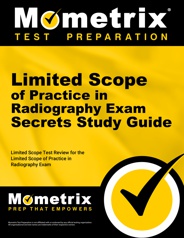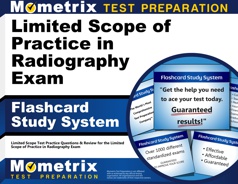The American Registry of Radiologic Technologists (ARRT) administers the Limited Scope of Practice in Radiography examination to evaluate the knowledge and cognitive abilities of operators of radiographic equipment used to radiograph specific anatomic regions.
Click “Start Test” above to take a free ARRT Limited Scope practice test!
Exam Eligibility
To be eligible for the exam, you must meet the entity requirements of the state you wish to take the exam in.
ARRT Limited Scope Exam Outline
The Limited Scope of Practice in Radiography exam is split into modules: a core module and one or more procedure modules. Every test-taker must take the full core module, but the procedure module(s) you take depends on your specific license area.
Core Module
The core module contains 115 questions, 15 of which are unscored “pilot” questions used to evaluate questions for future versions of the exam. You will have 1 hour and 55 minutes to answer all of the core module questions, most of which are multiple-choice.
The core module questions are grouped into five content areas:
Patient Interactions and Management (18 scored questions)
- Legal and ethical aspects
- Monitoring and ergonomics
- Interpersonal communication
- Medical emergencies
- Handling and disposal of toxic or hazardous material
- Infection control
Radiation Physics and Radiobiology (12 scored questions)
- Principles of radiation physics
- Biological effects of radiation
Radiation Protection (28 scored questions)
- Minimizing patient exposure
- Personnel protection
Image Acquisition and Evaluation (20 scored questions)
- Factors that affect radiographic quality
- Digital imaging characteristics
- Criteria for image evaluation
- Image identification
- Technique charts
Equipment Operation and Quality Assurance (22 scored questions)
- Imaging equipment
- Quality control of imaging accessories and equipment
- Image processing and display
Procedure Modules
The procedure modules contain 20-25 questions each, and there are five additional unscored “pilot” questions in each module, used to evaluate questions for future versions of the exam. You will have 25-30 minutes to answer the questions in each module, most of which are multiple-choice.
There are five procedure modules:
1. Chest (20 scored questions)
- Routine
- Other
2. Extremities (25 scored questions)
- Upper
- Lower
- Pectoral girdle
3. Skull/Sinuses (20 scored questions)
- Skull
- Facial bones
- Paranasal sinuses
4. Spine (25 scored questions)
- Cervical spine
- Sacrum, coccyx, and sacroiliac joints
- Thoracic spine
- Scoliosis series
- Lumbar spine
5. Podiatric (20 scored questions)
- Ankle
- Foot and toes
- Calcaneus
Check out Mometrix's Limited Scope Study Guide
Get practice questions, video tutorials, and detailed study lessons
Get Your Study Guide
Registration
To register for the exam, you must apply directly with your state licensing entity. If approved, the state will send you an instruction letter on how to pay exam fees to ARRT.
Once the fee is processed at ARRT, an online Candidate Status Report will be provided.
Once you receive your online Candidate Status Report, you may schedule an appointment online through the affiliated Pearson VUE website and search for testing centers near your location with their available examination schedules.
Test Day
On the day of the exam, you must arrive at the testing center 30 minutes before your scheduled exam time. During check-in, Pearson VUE will collect your digital signature, photo, and palm vein image. Biometric technology ensures that each examinee only has a single record in the system to safeguard the integrity of the exam.
You will be asked to leave your personal belongings in a small locker outside the testing room. During the exam, you are not allowed to use your smartphone, smartwatch, or other prohibited items.
Exam Scores
ARRT provides the exam results to the state licensing entity as number correct for each completed module. Your state entity will determine your pass/fail status and notify you of the results.
Check out Mometrix's Limited Scope Flashcards
Get complex subjects broken down into easily understandable concepts
Get Your Flashcards
FAQs
Q
How many questions are on the ARRT Limited Scope exam?
A
There are 115 core module questions on the exam, and there are 20-25 questions per procedure module.
Q
How long is the ARRT Limited Scope exam?
A
The core module is timed at 1 hour and 55 minutes, and each procedure module is timed at 25 or 30 minutes.
Q
How much does the ARRT Limited Scope exam cost?
A
The exam fee is $150.
ARRT® and R.T.® are registered trademarks owned by The American Registry of Radiologic Technologists. Mometrix.com is not licensed by, endorsed by, or affiliated with The American Registry of Radiologic Technologists.

